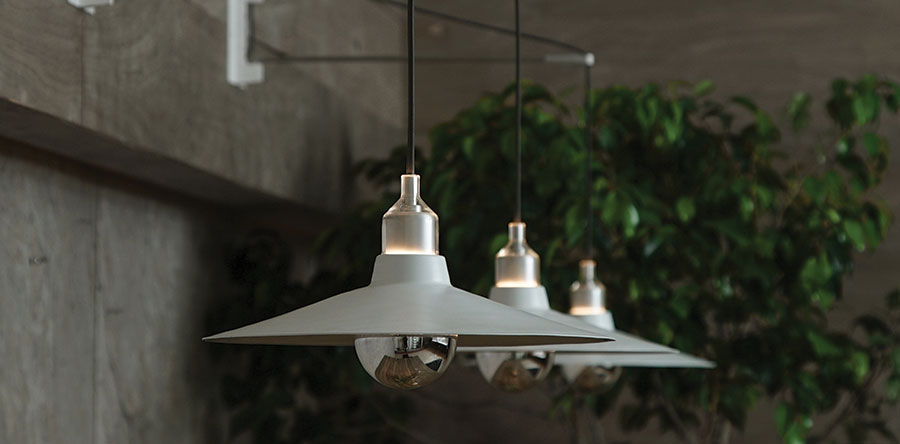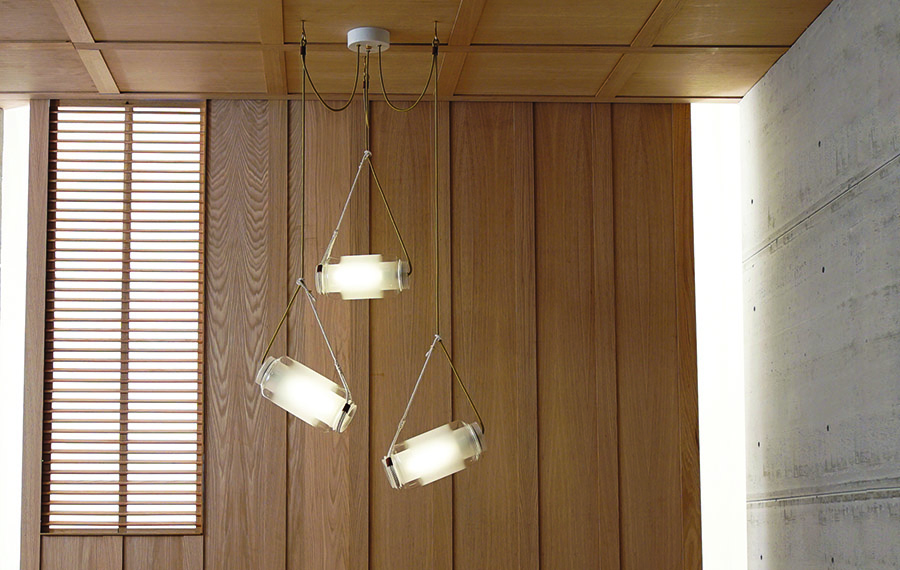This East Coast born and raised artist has been delightfully building with wood since childhood. Now on the West Coast, Brendan Ravenhill manufactures his Minimalist furniture and lighting lines using local resources.
[dropcap style=”letter” size=”52″ bg_color=”#ffffff” txt_color=”#8224e3″]N[/dropcap]ot many children have a castle in their backyard — and it’s even more scarce to have one built from scratch by the kids themselves with the help of their father. Then again, lighting and furniture designer Brendan Ravenhill admits he hails from a crafts-based family.

His late father, the curator of the National Museum of African Art in Washington D.C., enjoyed doing carpentry on the weekends and building bedroom furniture, fortresses, and treehouses for his sons and daughter. “He helped our projects come to life,” Ravenhill states.
The children attended inner-city public schools in the nation’s capital during the school year, however, in summertime Ravenhill’s parents took the family to Maine, where they could be immersed in the natural beauty of that state.
At Oberlin College in Ohio, Ravenhill toyed with the idea of majoring in Political Science — but then his father passed away. “There is something about the process of making something that really grounds me. Everything I knew about building was learned at my father’s knee,” he explains, “Maybe it’s my way of dealing with grief, but my father’s death really brought that [joy of craftmanship] back to me. Making things became my passion again as well as my therapy,” he notes. “The more I exposed myself to the different processes of making something, the more interested I became in it.”

Ravenhill switched his major to studio art and moved to Maine upon graduation where, for the next three years, he worked as a lobsterman while perfecting his skills by building a timber-framed barn to use as his studio. “Doing more complicated construction helped me continue to learn the craft,” he says of the project. From there, he studied Industrial Design at Rhode Island School of Design (RISD) and tackled the art of boat building.
When an opportunity arose for Ravenhill and his wife to join her sister’s family in California for a project, they moved across the country intending to “try it out” for a few years. Instead, the Ravenhills put down roots and still live in the Los Angeles area where he established his furniture and lighting manufacturing studio.
“Los Angeles is just an amazing resource for different kinds of fabricators,” he states. And while some manufacturers gripe about the tight restrictions imposed by the state, this artist embraces them. “Believe it or not, all of the regulations in California actually give me great comfort,” he remarks. “This state has high standards and manufacturing here lets my customers know that our products are made safely and responsibly.”

It was his previous barn-building experience that gave Ravenhill his first experience in understanding electricity and wiring. For that reason, segueing from manufacturing furniture pieces (i.e. tables and chairs) and accessories (for retailer West Elm) to lighting was not as daunting as one might assume.
“I think lighting is such an attractive discipline,” he comments, adding that with furniture, there are rules for how high a tabletop surface or seating should be. He’s found lighting design to be artistically liberating. “It’s much more free from a design perspective,” he notes. “There is so much opportunity.”
One such happenstance occurred when he was touring a local metal-spinning factory and was informed that the technique he was interested in would leave marks resembling woodgrain on the metal. In other words, the metal-spinner said, the aesthetic would be ruined. Ravenhill, on the other hand, only saw potential beauty. Dubbing the spun metal pendant line Grain, he played up the “flaw.”
“What I love about working with these various vendors is finding a way to maximize their strengths and celebrate their methods — that’s what gives each piece that extra something,” he says. “I love learning about each process and every detail. That ‘woodgrain’ look on the metal captured the soul and gave texture.”
Brendan Ravenhill Studio – which has grown to include 12 employees – has exhibited for the past five years at ICFF® (International Contemporary Furniture Fair) in Manhattan as well as L.A. Design Week, plus the company maintains a showroom in New York City.
“We’ve been establishing relationships with architects and designers,” he remarks. The success of his furniture and lighting designs for the renovation of Hollywood restaurant Osteria La Buca several years ago put him on the map for commercial work. Today, the firm’s business is roughly 50/50 commercial and residential. “Both areas are growing for us,” Ravenhill adds.
“We love collaborating with designers because it’s so inspirational,” he says. In fact, the company’s ADA series of sconces came about when a designer needed fixtures that were ADA-compliant and Ravenhill wasn’t yet familiar with the term. He was delighted to learn about the constraints of making lighting fixtures that would extend less than four inches from the wall; challenge is fun for this designer.
“I’ve also added swag hooks [for our fixtures] because I would hear from designers that the junction boxes in their clients’ homes weren’t always located in an ideal spot. We’re in the business of saying ‘yes’ to clients,” he states.
Another opportunity that Ravenhill is saying yes to is LED. “We have LED options for all of the lighting fixtures we offer,” he affirms. “We’re trying to make the migration to all-LED in the next year. LED is just so much more efficient!”
The newly launched Brendan Ravenhill Web site provides examples of successful projects as well as details about its furniture and lighting collections. “A lot of our work is a Minimalist aesthetic, but I like that,” he comments.
Ravenhill has surrounded himself with like-minded craftspeople who relish innovation and ingenuity as much as he does. His design firm welcomes commissioned and custom fabrication work whether it comes from restaurateurs, hotels, and major brands – as in the past – or from private clients seeking products tailored specifically to their needs or space.
The site also makes the firm’s mission clear: “We work to strike the perfect balance between material, function, and form in our designs. Our work is devoid of excess and ornament, striving for a logical celebration of physics, material, and craft. We find great reward in making beautiful things and are proud to build all our pieces in the USA.”





